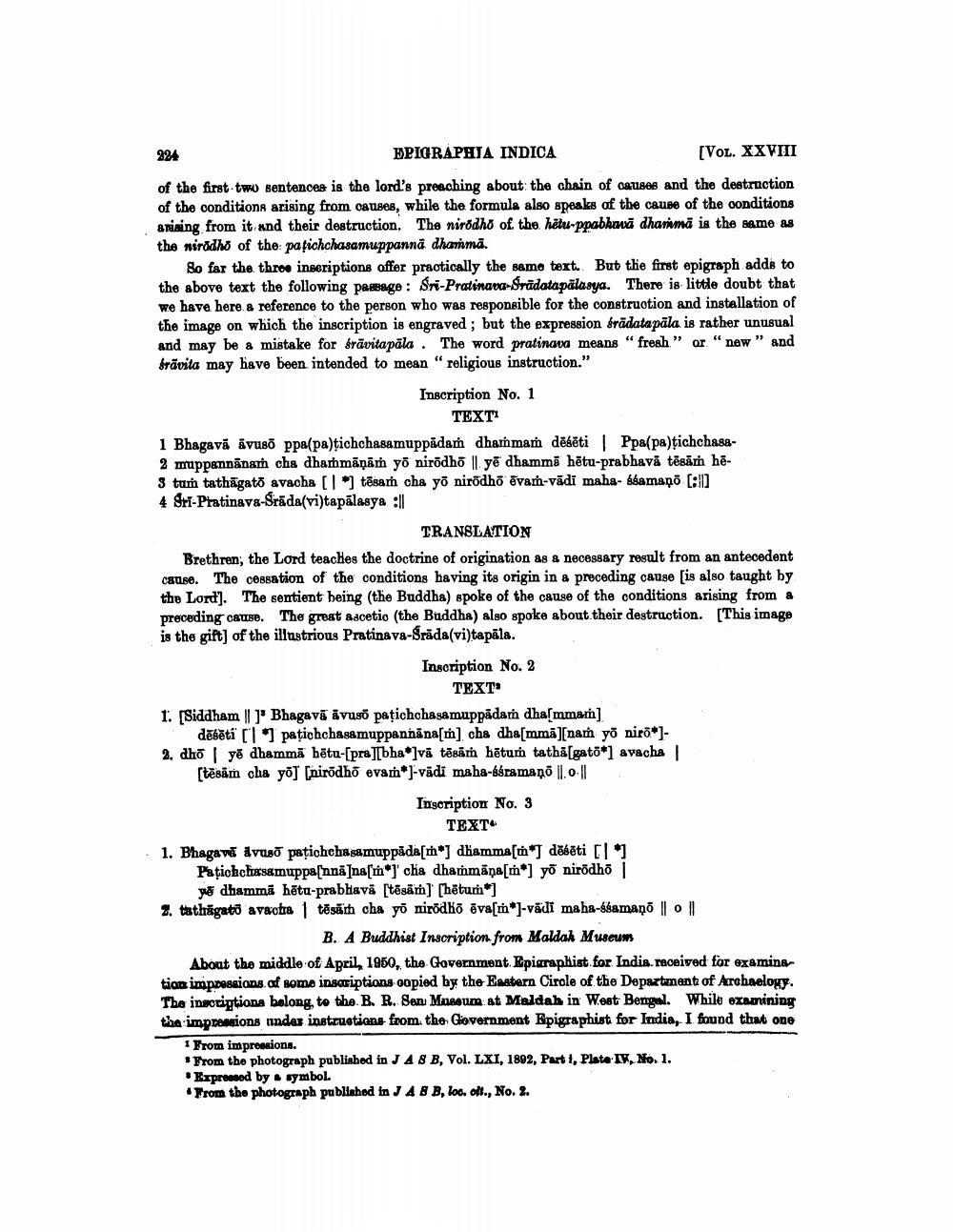________________
224
EPIGRAPHIA INDICA
[VOL. XXVIII
of the first two sentences is the lord's preaching about the chain of causes and the destruction of the conditions arising from causes, while the formula also speaks of the cause of the conditions arising from it and their destruction. The nirödho of the hetu-ppabhava dhamma is the same as the niradho of the patichchasamuppannā dhammā.
So far the three inscriptions offer practically the same text. But the first epigraph adds to the above text the following passage: Sri-Pratinava-Sradatapalasya. There is little doubt that we have here a reference to the person who was responsible for the construction and installation of the image on which the inscription is engraved; but the expression éradatapala is rather unusual and may be a mistake for śrävitapala. The word pratinava means "fresh" or "new" and bravita may have been intended to mean "religious instruction."
Inscription No. 1 TEXTI
1 Bhagavā āvusō ppa(pa)tichchasamuppādaṁ dhammaṁ dēsēti | Ppa(pa)ṭichchasa
2 muppannanam cha dhammanam yō nirodhō || ye dhamma hētu-prabhava tēsām hē
3 tam tathagato avacha [1] tesam cha yō nirödho evam-vādi maha- ssamanō [:] 4 Sri-Pratinava-Srada(vi)tapalasya :||
TRANSLATION
Brethren, the Lord teaches the doctrine of origination as a necessary result from an antecedent cause. The cessation of the conditions having its origin in a preceding cause [is also taught by the Lord']. The sentient being (the Buddha) spoke of the cause of the conditions arising from a preceding cause. The great ascetic (the Buddha) also spoke about their destruction. [This image is the gift] of the illustrious Pratinava-Srāda (vi)tapāla.
Inscription No. 2 TEXT
1. [Siddham Bhagavi &vuso paṭichchasamappidash dhammach]. děsěti []patichchasamuppannana[m] cha dha[mma][nam yō nirō*]2. dhō ya dhamma hetu-[pra][bha*]vā tēsām hētum tatha [gato*] avacha | [tesam cha yo] [nirodhō evam*]-vādi maha-ééramano |.0.||
Inscription No. 3 TEXT
1. Bhagava avuso pațichchasamuppada[m*] dhamma[m*] děśēti []*] Patichchasamuppa[nna]na[m] cha dhammapa[m] yo nirōdhō | ye dhamma hetu-prabhava [tēsām] [hētum*]
2. tathagato avacha | tesah cha yo nirödhō eva[m*]-vädi maha-samaņō || o ||
B. A Buddhist Inscription from Maldah Museum
About the middle of April, 1950, the Government. Epigraphist for India. received for examination impressions of some inscriptions copied by the Eastern Circle of the Department of Archaelogy. The inscriptions belong, to the. B. R. Sen Museum at Maldah in West Bengal. While examining the impressions under instructions from the Government Epigraphist for India, I found that one
1 From impressions.
From the photograph published in J A 8 B, Vol. LXI, 1892, Part 1, Plate IV, No. 1.
Expressed by a symbol.
From the photograph published in JAB B, loo. olt., No. 2.




